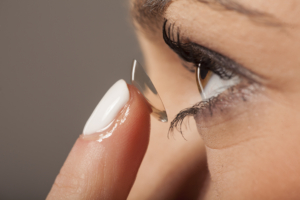Causes
- Congenital eye diseases
- Diabetic retinopathy
- Age related macular degeneration
- Myopic degeneration
- Glaucoma
- Retinitis pigmentosa
Treatment
The management of Low vision mainly involves counselling, low vision devices and rehabilitation depending on the individual needs of the patient.
Evaluation of low vision
Low vision is evaluated by a trained ophthalmologist or optometrist who specializes in this field. Patients are evaluated on the basis of age, degree of visual dysfunction, disease and requirement.
Types of low vision devices
There are two types of devices:
Optical devices:
- Magnifying glasses: Help for reading and writing
- Hand magnifier: Can be used in any position or angle
- Stand magnifier: Has a fixed distance for easy movement
- Telescope: Can be used in a classroom for blackboard or outdoors
- Electronic magnifier: CCTV, AMEGO, JORDY
Non-optical Devices:
- Table lamp
- Reading stand
- Bold tip pen
- Large print materials
Procedure
Patient is called in the LVA clinic for assessment and counselling. Then different low vision devices are tested depending on the patient’s need and comfort. After the ideal low vision device is identified, the patient is counselled for its cost, care and its utility, following which it is dispensed.
Benefits of low vision devices
- They help in improving near and distance vision
- They help in adapting to home, school, workplace and the nearby environment.
- THey help to build self confidence and feeling of independence
- They could be of use in office for the visually challenged
Contact Lens and Low Vision Aids
Contact lenses are an alternative to glasses for the correction of refractive errors (spectacle numbers). Worn by over 120 million people worldwide, there are various contact lens options including soft contact lenses (including disposable), toric contact lenses, cosmetic contact lenses and rigid Gas-permeable (semi-soft) contact lenses.
Mohan Optics offers rehabilitative services to patients with low vision in the form of various optical magnifiers, telescopes and electronic low vision aids. With these devices and proper motivation, people with visual loss can often read, do modified close-up work, and continue to take good care of themselves.
FAQs
What are contact lenses?
Contact lenses are small, thin, curved transparent discs that rest on the cornea, the front surface of the eye. Contact lenses cling to the film of tears over the cornea because of surface tension, the same way that a drop of water clings to the side of a glass. Contact lenses are mostly used to correct near-sightedness, far-sightedness and astigmatism.
What are the types of contact lenses available?
There are two types of contact lenses:
- Semi soft or Rigid Gas-permeable (RGP) Contact Lenses
- Soft Contact Lenses
Hard contact lenses have become obsolete now. Soft lenses can be further categorised depending on the type of wear: Daily wear Extended wear Disposable (quarterly, monthly, fortnightly, weekly and daily).
What are the advantages and disadvantages of each type of contact lens?
RGP (Semi-soft) lenses: These are made of special, firm plastics combined with other materials, such as silicone and fluoropolymers, which allow oxygen in the air to pass directly through the lens. These lenses are durable and typically last longer than soft lenses. They provide excellent quality of vision, have a long life, and can correct astigmatism as well as uneven curvature of the cornea.
There are some disadvantages, like these lenses take a little longer getting used to, and it’s easier for dust to get behind them, which can cause discomfort. This also makes it tough to switch back and forth with glasses as easily. However, regular wearers find them comfortable and the visual acuity outstanding.
Soft lenses are made of flexible water-absorbent (hydrophilic) material and have water content between 30-80%. These are comfortable from the time they are worn. They are less likely to dislodge and can be worn for longer periods. However, their biggest disadvantage is that they cannot correct higher degrees of astigmatism. They also need to be changed more frequently.
If I only wear my fortnightly-disposable contact lenses part time, do I still have to replace them every two weeks?
No, the two weeks refers to the actual amount of wearing time, so they can last longer than two weeks if you are not wearing them full time.
Do people experience discomfort or pain when using contact lenses?
Most people who try lenses for the first time are pleasantly surprised by the level of comfort lenses provide. A professional eye care specialist can help fit the lens for the first time to make it easier. After a brief adjustment period, most people report they can no longer feel contact lenses on their eyes.
Can contact lenses be “blinked” out?
Normally contact lenses will stay firmly in position. However, under certain conditions they can come out. High winds can cause the eyes to water and push the eyelid tight against the eye, increasing the chance of the lens coming out, as can rubbing your eyes too much. A blow to the head may dislodge semi-soft lenses. Discuss your lens usage with your eye care specialist so she/he can recommend a suitable lens for you.
What are the basics of daily contact lens care? What are my options?
The basics of contact lens care include cleaning, disinfecting (for storing) and rinsing. Cleaning solutions remove dirt, protein, oils, mucus, and debris that get on the lens during wear. Disinfecting solutions kill bacteria and other germs on the lenses and help prevent eye infections. Rinsing solutions remove other solutions from the lenses and prepare the lenses for wear. Enzyme solutions remove protein and other deposits that accumulate on the lenses over time. Rewetting solutions are used to wet (lubricate) the lenses while you are wearing them, to make them more comfortable.
These steps can be performed using separate solutions. However, recently, there has been a strong movement to “one-bottle” systems. These all-in-one solutions are the easiest and quickest to use. If you are particularly sensitive to chemicals, it may be better to use a hydrogen peroxide system. One must remember that all contact lens cases need frequent cleaning, including disposable lens cases. As a rule don’t bring any contact lenses in contact with tap water as it can be a source of serious (sight-threatening) eye infection.
Is it OK to play sports while wearing contact lenses?
There are advantages to wearing lenses while playing sports, as it’s a more flexible and stable form of eye correction than glasses. Lenses don’t steam up with perspiration and temperature change. They provide better depth perception and complete peripheral vision. Today’s close-fitting contacts stay on your eyes, even during vigorous activity. If the sport you play involves vigorous exercise, a soft contact lens is an appropriate choice.
Is it OK to swim while wearing contact lenses?
Pool water can cause discomfort due to chlorine. It is best to avoid swimming with your contact lenses on because it exposes your contacts to bacteria and other microorganisms in the water and there is a risk of infection. If you do swim with your lenses, you should wear well fitted goggles, or the lenses may float out of the eyes. They may also absorb the pool water, one consequence of which may be that they adhere too firmly to the eye. If this happens, leave the lenses alone for 10-15 minutes until your natural tears have replaced the water in them, before trying to remove them. Disinfect them immediately afterwards.
I have dry eye problems. Can I wear contact lenses?
Dry eyes reduce your chances of success with contact lenses, but it doesn’t mean you can’t wear them at all. You may have a shorter contact lens wearing period than normal or that you may choose to wear your lenses only occasionally. You can increase the comfort of your lenses by inserting eye lubricating drops.
Should I wear contact lenses while travelling by plane?
Due to low humidity in the aircraft cabins, one may get dry eye symptoms and hence contact lens discomfort. It may be helpful to put lubrication drops in your eyes before flying. If symptoms persist or become severe, it is probably easiest and best to wear eyeglasses when flying.
Who should not wear contact lenses?
Most people can wear contact lenses with ease. However, there are some exceptions. Contact lens may not be the right choice for someone who is prone to frequent eye infections, severe allergies, severe dry eye (improper tear film), a work environment that is very dusty or dirty, or inability to handle and care for the lenses properly.
Can contact lenses be fit if I have had refractive surgery and have a residual spectacle number?
Yes, but the refractive surgery will have altered the contour of your eyes, requiring a more specialised lens than normal. It is best to consult your eye care practitioner who will advise you based on the details of your specific history and requirements.

